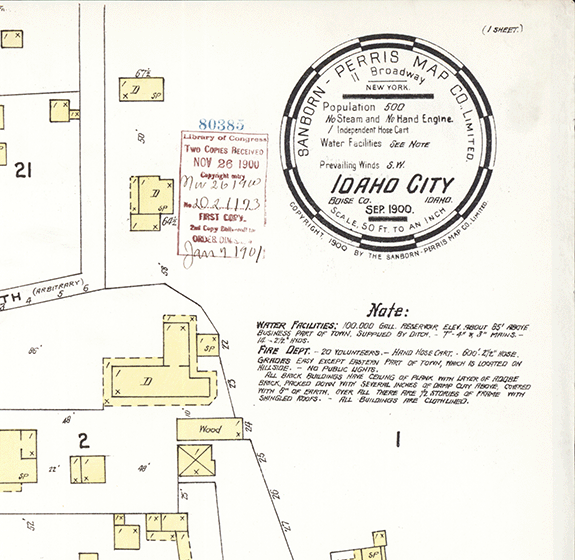Historic Idaho City
Boom Town
When gold was discovered in 1862, Idaho City was built nearly instantly. Originally known as Bannock, Idaho City became one of the largest cities in the Pacific Northwest. It’s population quickly swelled to approximately 7,000 with an estimated 25,000 individuals residing nearby. Idaho City was well known, a book published in Missouri detailing the route to the Idaho gold rush listed the capital of Idaho as Idaho City. Idaho City not only grew quickly but was also rebuilt many times as fires would break out. Because of fire, most of the historic buildings remaining were built of brick after the city was established.
One of the best depictions of how impressive Idaho City was is this Sanborn Map created in 1900 for fire insurance purposes. It’s important to note that by this time Idaho City had greatly diminished in population. As gold became harder to mine, the miners moved on. The map’s creator marked Idaho City’s population as 500, less than a tenth of the population just 6 years earlier.
Another interesting feature of this map is that the creator noted building occupied by Chinese, marked frequently as “Chine”. Idaho City had a very large Chinese population from 1864 to early 1900’s. Many of the original mining claims in 1862 were sold as the mining became more difficult, many to Chinese miners.
While this map shows a city with many saloons, black smiths, and services like laundry and restaurants, it’s important to remember this was mapped after over 90% of the population had left.
Near Ghost Town
Mining operations in the Boise Basin slowed significantly over time. As gold became increasingly difficult to mine, the large population of miners moved on. From 7,000 residents in 1864, 500 in 1900, down to 104 in 1920. A likely consideration for individuals was livelihood. With the gold rush over, the town had no major exports and no meaningful agriculture. It is likely many of the residents may have moved to Boise, which continued to grow. The Treasure Valley offered range land for animals and by 1910 had an irrigation system for farming. Boise’s population in 1920 was over 20,000. It’s important to note that just as Idaho City had a large Chinese population, so did Boise. Further developments in the city saw the destruction of most of the original Chinese structures though.
Modern Idaho City
What remained of Idaho City’s historic downtown has been preserved over the years. Some buildings date back to the 1860’s. While many of the buildings are now newer, Idaho City maintains its historic look downtown. Visiting Idaho City is an amazing look back into the history of Idaho itself. Idaho City Historical Foundation is proud to work to preserve the properties it cares for, for the enjoyment of anyone interested in this history. Idaho City is a great town to explore, with many unique shops and great restaurants. If you plan to explore Idaho’s great outdoors, you should plan to stop in on the way.

